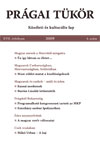
 |
| 2009/4 | resumé | ||
 tartalom e számunk szerzői bemutatkozik támogatóink
|
Summary
This year's fourth issue brings in its section Hungarian destinies west of Moravia an interview with Aranka Bednářová, who now lives in the Czech Republic for several decades. Mrs. Bednářová speaks in detail about her life, about her encounter with the reality of living in Bohemia, about her love of Hungarian culture and about the importance of conserving your mother tongue. As an active member of the Union of Hungarians she also comments on the activities of the Union and of other Hungarian organizations in the Czech Republic including the ecclesiastic ones. She also speaks of her relationship with faith. In the section Hungarians in Bohemia, Moravia and Silesia we write about the northern Bohemian city of Most, which takes great care of the minorities living on its territory. The mayor of the city had a debate on this topic with the Hungarian ambassador László Szőke and the president of the Union Anna Rákóczi. The section Hungarians and Czechs - the present and the past, brings information about the Hungarian city of Szentendre having opened a grand exhibition of modern painters from Košice. We also report the honour received by the catholic priest László Burian, who has been taking care of Hungarians deported to former Czechoslovakia after the Second World War. Due to the occasion of this year (2009) being the year of the Hungarian language, University professor István H. Tóth continues with his series of articles about the history of the Hungarian language. In this issue we bring you the fourth chapter. In the section named From Prague to Bucharest we write amongst others also about the meeting of the political party “Strana maďarské koalice”(Hungarian coalition party) which took place in Rimavská Sobota. The hallmark of the official meeting was the acceptance of the parties political agenda for the next twenty years. Modern Hungarian literature is represented by the writer Ákos Kertész. The author of the article and of the translation is Radek Patloka. Czech literature is represented by the short story by Miloš Urban. The translation was done by the well known interpreter Margit Zádor. The appendix Tükörkép brings detailed information about the days of Hungarian culture in Prague and Ostrava. It also talks about the 40th anniversary of the foundation of the student club KAFEDIK in the city of Brno. And as usually, last but not least we have the traditional appendix for children containing poetry and fair.
|
||